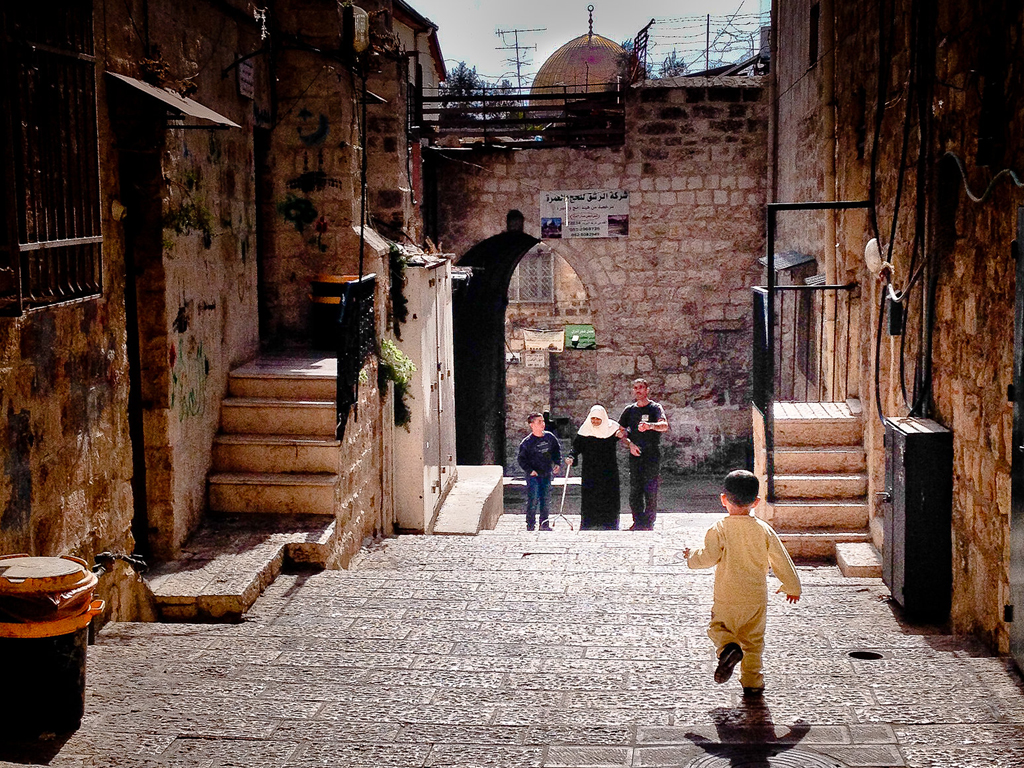The new Israeli government that was sworn in on June 13 is celebrating one month in office. It is the result of an unprecedented eclectic coalition made up of leftist, centrist, hard-core right-wing Jewish parties and an Arab Islamist party—without which this particular coalition would not have seen the light of day. The formation of this government seemed almost unthinkable after the last round of violence between Hamas and Israel, which ended with a ceasefire on May 21.
Both Israel and Hamas publicly declared victory after eleven days of violence, despite the death toll and devastation in the Gaza Strip, on the one hand, and the failure of the Israeli army to stop Hamas from firing rockets into Israel’s urban centers, on the other. Unlike previous rounds of violence between Israel and Hamas, this one was marked by internal strife inside Israel involving Arab and Jewish citizens of the country, which threatened to tear the delicate fabric of Jewish-Arab cohabitation. While winners and losers, in this round or others, may be in the eye of the beholder, the Palestinian-Arab citizens of Israel might be the community with the most at stake as a result of this last violent skirmish.
Survivors of the 1948 war, and approximately 20 percent of the Israeli population (then and still now), this community has experienced its fair share of discrimination and marginalization since the establishment of the state of Israel. Founded as a Jewish state, Israel has both tolerated and subdued its Palestinian Arab citizens for the past seventy-three years.
Parallel political processes
In recent decades, Palestinian Arabs have experienced two parallel—and often conjoined—processes of Israelization and Palestinization. The former has been expressed through deeper integration into the Israeli economy, access to higher education in Israeli academic institutions, the adoption of certain Israeli social practices, and active participation in Israeli politics—though never as equal partners. Concomitantly, increasing identification and activism in support of Palestinian national and civil rights in the West Bank and the Gaza Strip has marked Palestinian Arab politics, as has mobilization for Palestinian national self-expression inside Israel in its pre-1967 borders.
The tangible expressions of both Israelization and Palestinization have been especially prominent this past year. The pressure created by the COVID-19 crisis on hospitals and medical services in Israel exposed the fact that about 20 percent of all medical workers in the country are Palestinian Israelis (47 percent of the pharmacists, 24 percent of the nurses, 17 percent of the physicians). While the numbers are lower in other sectors, reflecting continued discrimination, it is still common to see Arab citizens integrated into other professions, including government civil service, where they make up about 12 percent of the work force.
Greater demand for equality
At the same time, during Ramadan, when Israeli security forces restricted access to the Noble Sanctuary (al-Haram al-Sharif) in Jerusalem and responded with extreme violence to Palestinian protestors in East Jerusalem, Arab citizens of Israel mobilized in support of their compatriots in the city, defending the Noble Sanctuary which all Palestinians consider a symbol of their national identity. When Israel moved forward with plans to evict Palestinian residents of Sheikh Jarrah in East Jerusalem, it was not only Hamas in Gaza that threatened retaliatory violence (and carried out the threat): Palestinian citizens of Israel also protested against Israeli actions, which they perceive as the continued effort of Judaification of the country at the expense of its Palestinian Arab population.
The unprecedented eruption of mob violence in mixed Jewish-Arab cities and elsewhere became living proof of the challenges of cohabitation in Israel. While some Arab violence was carried out by criminal gangs and individuals, large parts of the Palestinian Israeli protest were genuine, inspired by justified long-standing grievances of discrimination and marginalization. In fact, the growing Arab integration inside Israel noted above has motivated its Palestinian Arab citizens to expect and demand more equality with the Jewish majority. Past marginalization on the individual and national/communal levels that might have been grudgingly accepted in the past is no longer accepted. The more integrated they become, the greater their demand for civil equality.
On the Israeli-Jewish side of the equation, radical right-wing and religious Jewish citizens, who today are also represented in the Knesset, see Arab integration into Israel as a threat to the Jewish identity of the country. Some of them are using the language of racial purity taken straight from European racial discourse of the late nineteenth to mid-twentieth century. In fact, fear of growing Arab participation in Israeli politics and society has been expressed not only on the extreme margins of the Jewish population but also by statements and actions from the supposed mainstream, including the passing of discriminatory laws, such as the Basic Law: Israel as the Nation-State of the Jewish People, which blatantly undermines the status of the Arab minority in Israel. During the most recent conflict between Hamas and Israel, these trends inspired the Jewish mobs that swarmed the streets of mixed towns and carried out acts of violence against their Arab residents, who are, no less than the Jewish rioters themselves, citizens of Israel.
The aftermath of this last round of violence between Hamas and Israel, including the swearing in of a new government, also reflects these two contradictory trends: that of continued, though haphazard, integration, on the one hand, and suppression and marginalization on the other hand. For example, the previous government swiftly responded to the internal Jewish-Arab violence by unleashing the security forces against Palestinian citizens of Israel and arresting a high number of Arab protestors, compared with a relatively low number of Jewish arrests.
This historic precedent could facilitate future Jewish-Arab coalitions and cooperation.
Conversely, the new government constitutes a milestone in Jewish-Arab relations in Israel. For the first time since the founding of the state, the coalition was made possible with the support of Ra’am, an Arab Islamist party, that agreed to join the new coalition in exchange for economic benefits for its constituencies. In addition, for the second time in Israel’s history, a Palestinian Arab Muslim—Issawi Freij, who is a member of Meretz, a Zionist leftist party—holds a ministerial position in the government. While one could argue that the participation of Arabs in this mostly center-right-wing coalition is no more than pure opportunism and a fig leaf that hides structural discrimination, it is impossible to ignore the fact that a historic precedent has been set that could facilitate future Jewish-Arab coalitions and cooperation. It opens up possibilities for the recognition of human dignity at the level of Israeli high politics that we have rarely seen before.
After only one month in office, the government is already being affected by Jewish-Arab and Israeli-Palestinian dynamics. On July 6, the government tried and failed to pass a law that bans citizenship for Palestinians from the West Bank and the Gaza Strip who marry Palestinian citizens of Israel. While Ra’am Knesset members surely abhorred this proposed law, two of them voted in favor and two abstained. Their vote demonstrated their pragmatic approach that, for now, places the survival of the government before their resentment of this discriminatory law. Ironically, most of the opposition, composed of right-wing and Jewish religious parties, voted against the law in order to embarrass the government, despite the fact that ideologically they were in full accordance with the bill’s premise. As the Jewish saying goes, “the work of the righteous is done by others.”
Palestinian citizens of Israel embody both the possibilities and the challenges of Jewish-Arab cohabitation in one political entity.
Yet another example of the extraordinary dynamics of this government is the recent decision of Issawi Freij, the aforementioned Minister of Regional Cooperation, to renew the work of the joint economic committee between Israel and the Palestinian Authority, a committee that has not met since former Prime Minister Binyamin Netanyahu took office in 2009. While it will not make a dent on the structural conditions of the conflict, the decision is a positive step forward that would likely not have happened were the minister not a Palestinian citizen of Israel.
As Israel continues to control the entire land from the Mediterranean Sea to the Jordan River and “one state” has become an operational reality, Palestinian citizens of Israel embody both the possibilities and the challenges of Jewish-Arab cohabitation in one political entity. Their relative integration into certain sectors of the country demonstrates that Jewish-Arab cohabitation, if not coexistence, may be more feasible than many argue. At the same time, the continued ethnicization of the conflict and the racialized discourse that has taken hold in Jewish right-wing circles, as well as religious maximalist views among Palestinians and Jews alike, make Jewish-Arab cooperation and cohabitation more fragile than ever. If the new government overcomes its multiple challenges, and in particular its (unequal) Jewish-Arab partnership, and if human dignity is acknowledged among its members, it would constitute a landmark achievement and open the door for new possibilities which, only two months ago, seemed unlikely.
Asher Kaufman is the Regan Director of the Kroc Institute for International Peace Studies and professor of history and peace studies in the Keough School of Global Affairs at the University of Notre Dame.
This article is part of a series of blog posts published by the Keough School of Global Affairs. Dignity and Development provides in-depth analysis of global challenges through the lens of integral human development.
Photo: “Young Palestinian boy running down an alley in the Arab Quarter of Jerusalem’s Old City” by eriktorner is licensed under CC BY-NC-SA 2.0.



